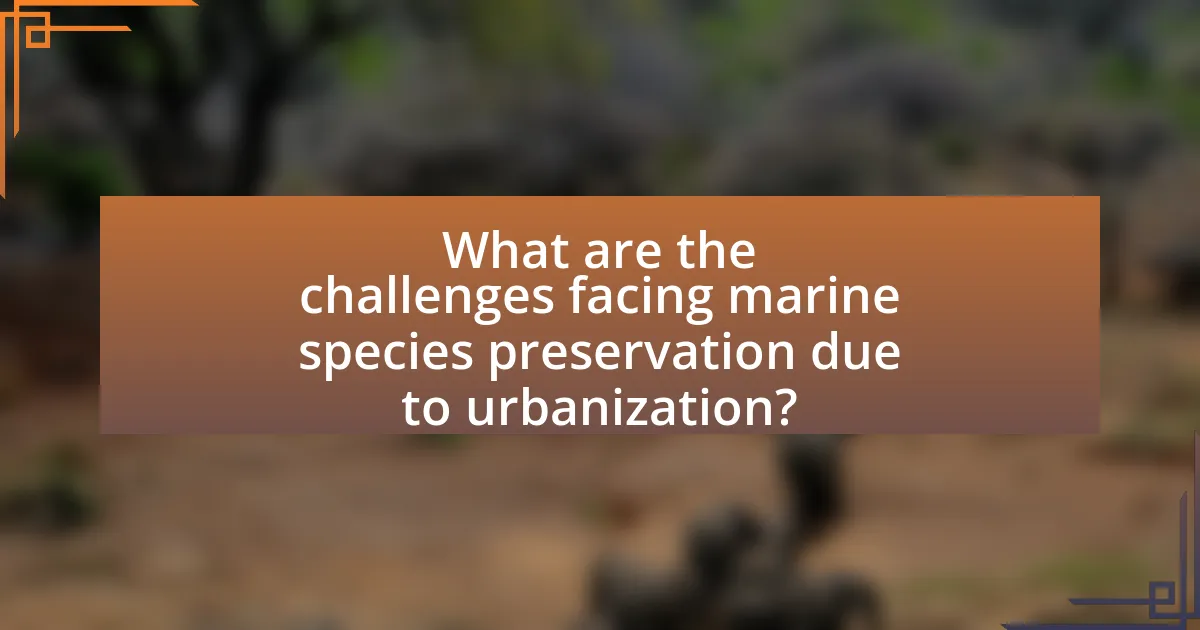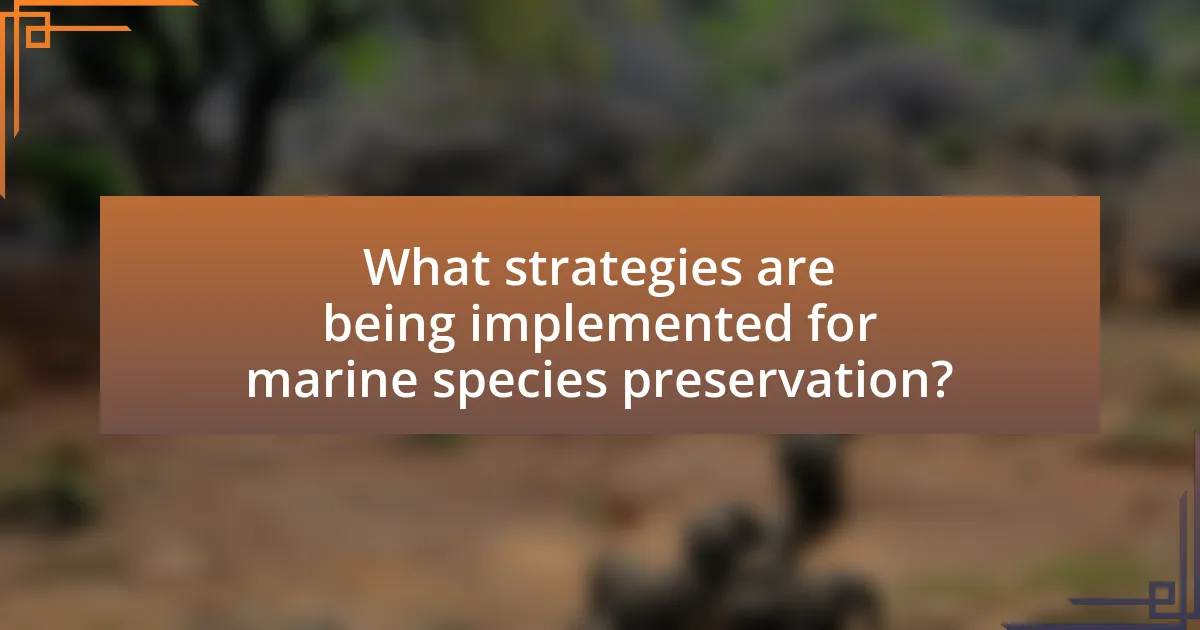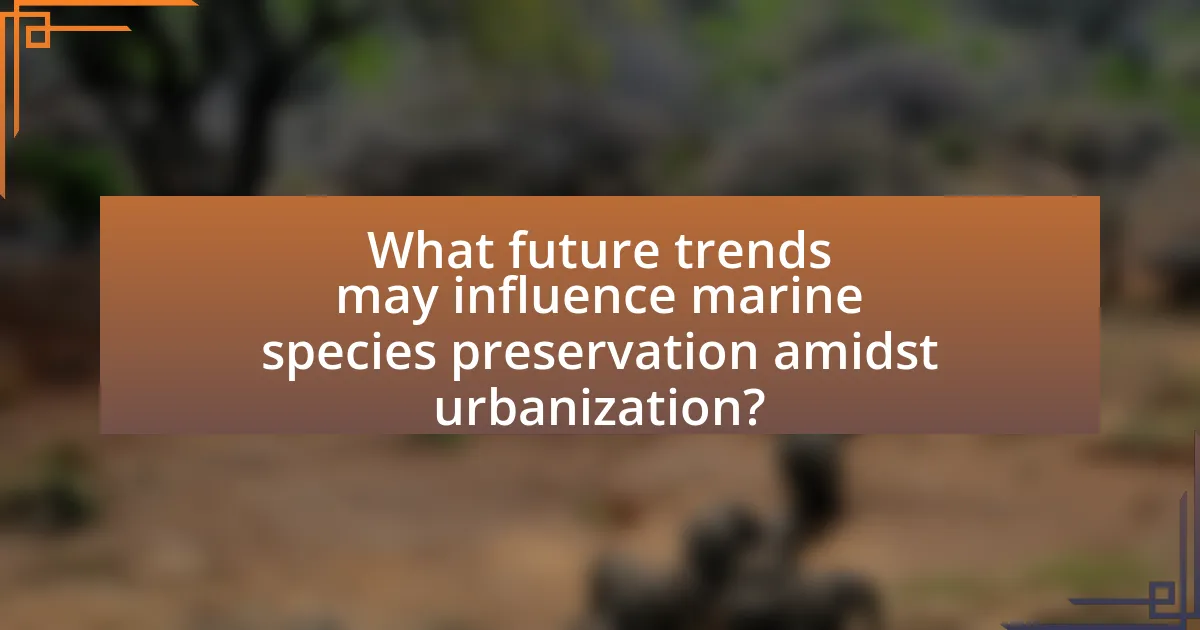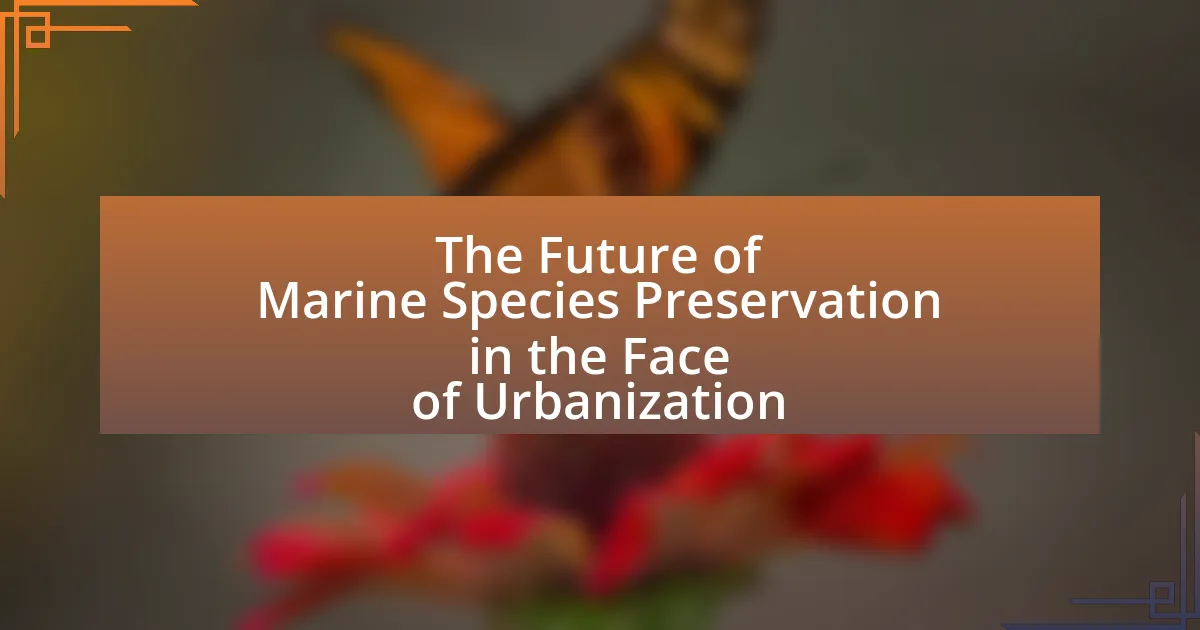The article focuses on the challenges of marine species preservation amid urbanization, highlighting issues such as habitat destruction, pollution, and increased human activity that threaten marine ecosystems. It discusses the negative impacts of urban runoff, overfishing, and coastal development on marine biodiversity and ecosystem health. The article also outlines strategies for preservation, including the establishment of marine protected areas, sustainable fishing practices, and community engagement in conservation efforts. Additionally, it emphasizes the role of technology and policy in enhancing marine conservation, while providing practical steps individuals can take to support marine species preservation.

What are the challenges facing marine species preservation due to urbanization?
Urbanization poses significant challenges to marine species preservation, primarily through habitat destruction, pollution, and increased human activity. Habitat destruction occurs as coastal areas are developed for housing, industry, and infrastructure, leading to the loss of critical ecosystems such as mangroves and coral reefs, which are essential for many marine species’ survival. Pollution from urban runoff introduces harmful chemicals and waste into marine environments, adversely affecting water quality and marine life. Additionally, increased human activity, including fishing and boating, disrupts marine habitats and can lead to overfishing and the decline of vulnerable species. These factors collectively threaten biodiversity and the health of marine ecosystems, making preservation efforts increasingly difficult.
How does urbanization impact marine ecosystems?
Urbanization negatively impacts marine ecosystems by increasing pollution, habitat destruction, and altering water flow. Urban development leads to runoff containing pollutants such as heavy metals, nutrients, and plastics, which degrade water quality and harm marine life. For instance, studies show that urban runoff can increase nutrient levels in coastal waters, leading to harmful algal blooms that deplete oxygen and create dead zones, adversely affecting fish and other marine organisms. Additionally, the construction of coastal infrastructure disrupts natural habitats, such as mangroves and coral reefs, which are crucial for biodiversity and serve as nurseries for many marine species.
What specific urban activities threaten marine habitats?
Urban activities that threaten marine habitats include coastal development, pollution, and overfishing. Coastal development, such as the construction of buildings and infrastructure, leads to habitat destruction and alteration of natural shorelines, which can disrupt local ecosystems. Pollution from urban runoff introduces harmful chemicals and waste into marine environments, negatively impacting water quality and marine life. Overfishing, driven by urban demand for seafood, depletes fish populations and disrupts the balance of marine ecosystems. These activities collectively contribute to the degradation of marine habitats, threatening biodiversity and the health of oceanic environments.
How do pollution and runoff from urban areas affect marine life?
Pollution and runoff from urban areas significantly harm marine life by introducing harmful substances and altering ecosystems. Urban runoff often contains pollutants such as heavy metals, nutrients, and pathogens, which can lead to toxic conditions for marine organisms. For instance, excess nitrogen and phosphorus from fertilizers can cause algal blooms, depleting oxygen levels and creating dead zones where marine life cannot survive. Studies have shown that areas with high urban runoff experience reduced biodiversity and increased mortality rates among fish and invertebrates. Additionally, pollutants can accumulate in the food chain, affecting not only marine species but also the humans who rely on them for food.
Why is marine species preservation important in urbanized areas?
Marine species preservation is crucial in urbanized areas because it maintains biodiversity and ecosystem health, which are essential for environmental stability. Urbanization often leads to habitat destruction, pollution, and overfishing, threatening marine life. For instance, studies show that urban runoff can introduce harmful pollutants into coastal waters, negatively impacting marine species and their habitats. Preserving marine species helps sustain fisheries, supports tourism, and enhances coastal resilience against climate change, as diverse ecosystems are better equipped to adapt to environmental changes.
What role do marine species play in ecosystem health?
Marine species are crucial for maintaining ecosystem health as they contribute to biodiversity, nutrient cycling, and habitat structure. For instance, fish populations help regulate prey species, while coral reefs provide essential habitats for numerous marine organisms. Studies indicate that ecosystems with higher marine biodiversity are more resilient to environmental changes, such as climate change and pollution. Additionally, marine species like phytoplankton play a vital role in carbon fixation, contributing to global oxygen production and influencing climate regulation. Thus, the presence and diversity of marine species directly correlate with the overall health and stability of marine ecosystems.
How does the loss of marine biodiversity affect human communities?
The loss of marine biodiversity negatively impacts human communities by disrupting food security, economic stability, and ecosystem services. As marine species decline, fisheries suffer, leading to reduced fish stocks that many communities rely on for sustenance and income. For instance, the Food and Agriculture Organization reported that over 30% of global fish stocks are overfished, directly affecting livelihoods in coastal regions. Additionally, the decline in biodiversity diminishes the resilience of marine ecosystems, which provide essential services such as coastal protection and carbon sequestration. This loss can exacerbate the effects of climate change, further threatening human communities dependent on healthy marine environments.

What strategies are being implemented for marine species preservation?
Strategies being implemented for marine species preservation include the establishment of marine protected areas (MPAs), sustainable fishing practices, and habitat restoration initiatives. Marine protected areas, which cover approximately 7.6% of the world’s oceans, help safeguard critical habitats and biodiversity by restricting harmful activities. Sustainable fishing practices, such as catch limits and gear modifications, aim to reduce overfishing and bycatch, thereby supporting population recovery. Habitat restoration initiatives, including coral reef rehabilitation and mangrove restoration, enhance ecosystem resilience and provide essential services for marine life. These strategies are supported by scientific research indicating that effective management can lead to increased marine biodiversity and healthier ecosystems.
How can urban planning integrate marine conservation efforts?
Urban planning can integrate marine conservation efforts by incorporating coastal zone management practices that protect marine ecosystems while accommodating urban development. This approach includes establishing marine protected areas (MPAs) within urban coastal regions, which can enhance biodiversity and support sustainable fisheries. For instance, cities like San Diego have implemented zoning regulations that limit coastal development to preserve critical habitats, demonstrating that urban growth can coexist with marine conservation. Additionally, integrating green infrastructure, such as wetlands and living shorelines, into urban designs can improve water quality and provide natural habitats, further supporting marine life.
What are the best practices for sustainable coastal development?
The best practices for sustainable coastal development include integrated coastal zone management, habitat restoration, and community engagement. Integrated coastal zone management ensures that environmental, economic, and social factors are considered in planning and development, which helps to balance human activities with ecosystem health. Habitat restoration, such as replanting mangroves and restoring wetlands, enhances biodiversity and protects shorelines from erosion. Community engagement fosters local stewardship and ensures that development meets the needs of residents while preserving marine ecosystems. These practices are supported by research indicating that sustainable coastal development can lead to improved resilience against climate change and better preservation of marine species.
How can green infrastructure support marine species preservation?
Green infrastructure can support marine species preservation by enhancing coastal ecosystems and improving water quality. This approach includes the creation of wetlands, green roofs, and permeable surfaces that reduce runoff and filter pollutants before they reach marine environments. Studies show that restored wetlands can provide critical habitat for fish and other marine organisms, while also acting as natural buffers against storm surges and flooding, which are increasingly important in urbanized areas. For instance, the National Oceanic and Atmospheric Administration (NOAA) reports that coastal wetlands can improve water clarity and reduce nutrient loading, both of which are essential for the health of marine species.
What role do community initiatives play in marine conservation?
Community initiatives play a crucial role in marine conservation by fostering local engagement and stewardship of marine resources. These initiatives empower communities to take action in protecting their coastal environments, often leading to sustainable practices that benefit both marine ecosystems and local livelihoods. For instance, community-led programs in areas like the Philippines have successfully implemented marine protected areas, resulting in increased fish populations and biodiversity. Research indicates that when local communities are involved in conservation efforts, compliance with regulations improves, and the overall effectiveness of marine conservation strategies is enhanced.
How can local communities contribute to preserving marine species?
Local communities can contribute to preserving marine species by engaging in sustainable fishing practices and participating in conservation initiatives. Sustainable fishing helps maintain fish populations and ecosystems, reducing overfishing and habitat destruction. For instance, community-led programs in coastal areas have successfully implemented catch limits and seasonal closures, leading to a 30% increase in local fish stocks over five years, as reported by the Marine Conservation Society. Additionally, local communities can organize beach clean-ups and habitat restoration projects, which directly improve marine environments and support biodiversity. Research shows that areas with active community involvement in conservation see a 50% higher success rate in marine species recovery compared to those without such initiatives.
What successful case studies exist for community-led marine conservation?
Successful case studies for community-led marine conservation include the establishment of the Apo Island Marine Reserve in the Philippines, where local fishermen collaborated to create a no-take zone, resulting in a significant increase in fish populations and biodiversity. Another example is the community-managed marine areas in Fiji, which have led to improved fish stocks and enhanced livelihoods for local communities through sustainable fishing practices. Additionally, the MPA (Marine Protected Area) initiatives in Madagascar, driven by local communities, have successfully restored coral reefs and increased marine biodiversity, demonstrating the effectiveness of community involvement in marine conservation efforts.

What future trends may influence marine species preservation amidst urbanization?
Future trends that may influence marine species preservation amidst urbanization include the implementation of green infrastructure, advancements in marine conservation technology, and increased public awareness and engagement. Green infrastructure, such as artificial reefs and marine protected areas, can enhance habitat quality and biodiversity, as evidenced by studies showing that these initiatives can lead to a 20-30% increase in marine species abundance. Advancements in technology, such as remote sensing and genetic monitoring, allow for more effective tracking of marine populations and ecosystems, facilitating timely conservation actions. Additionally, rising public awareness about the importance of marine ecosystems is driving community-led conservation efforts, which have been shown to improve local marine biodiversity by up to 40% in some regions.
How is technology shaping marine conservation efforts?
Technology is significantly shaping marine conservation efforts by enabling advanced monitoring, data collection, and analysis of marine ecosystems. Innovations such as satellite imagery, underwater drones, and remote sensing technologies allow researchers to track changes in marine habitats, assess biodiversity, and monitor the health of marine species in real-time. For instance, the use of autonomous underwater vehicles (AUVs) has been shown to enhance the accuracy of data collection on fish populations and coral reef health, leading to more effective conservation strategies. Additionally, data analytics and machine learning are being employed to predict the impacts of climate change on marine environments, facilitating proactive measures to protect vulnerable species. These technological advancements are crucial in addressing the challenges posed by urbanization and environmental degradation, ultimately contributing to more sustainable marine conservation practices.
What innovative tools are being used for monitoring marine species?
Innovative tools for monitoring marine species include acoustic telemetry, environmental DNA (eDNA) analysis, and satellite tracking. Acoustic telemetry utilizes underwater sensors to track the movements and behaviors of marine animals in real-time, providing valuable data on their habitat use and migration patterns. Environmental DNA analysis allows researchers to detect the presence of species in a given area by analyzing genetic material collected from water samples, which enhances biodiversity assessments. Satellite tracking employs GPS technology to monitor the long-distance movements of marine species, offering insights into their migratory routes and habitat preferences. These tools collectively enhance our understanding of marine ecosystems and inform conservation strategies.
How can data analytics improve conservation strategies?
Data analytics can significantly improve conservation strategies by enabling data-driven decision-making and enhancing the understanding of marine ecosystems. By analyzing large datasets related to species populations, habitat conditions, and human impacts, conservationists can identify trends, assess risks, and prioritize areas for intervention. For instance, a study published in “Nature” by Halpern et al. (2015) demonstrated that spatial data analysis could effectively identify critical habitats for marine species, leading to more targeted conservation efforts. Additionally, predictive modeling can forecast the impacts of urbanization on marine biodiversity, allowing for proactive measures to mitigate threats. This evidence-based approach ensures that resources are allocated efficiently and that conservation strategies are tailored to the specific needs of marine species in urbanized environments.
What policies are needed to enhance marine species preservation in urban areas?
To enhance marine species preservation in urban areas, policies must focus on habitat protection, pollution reduction, and sustainable urban planning. Implementing marine protected areas (MPAs) within urban coastal zones can safeguard critical habitats, while regulations on runoff and waste management can significantly decrease pollution levels affecting marine ecosystems. Additionally, integrating green infrastructure, such as wetlands and permeable surfaces, into urban development can improve water quality and provide natural habitats. Evidence from studies indicates that cities with effective MPAs and stringent pollution controls have seen a resurgence in local marine biodiversity, demonstrating the effectiveness of these policies in preserving marine species.
How can legislation support sustainable urban development for marine ecosystems?
Legislation can support sustainable urban development for marine ecosystems by establishing regulatory frameworks that protect marine habitats and promote responsible coastal management. For instance, laws can enforce restrictions on pollution, mandate the preservation of critical habitats, and regulate coastal development to minimize ecological disruption. The Clean Water Act in the United States exemplifies this, as it sets standards for water quality and regulates discharges into navigable waters, thereby safeguarding marine ecosystems from urban runoff and industrial waste. Additionally, legislation can incentivize sustainable practices, such as the use of green infrastructure and the restoration of degraded marine environments, which are essential for maintaining biodiversity and ecosystem health in urban settings.
What international agreements impact marine conservation efforts?
International agreements that impact marine conservation efforts include the United Nations Convention on the Law of the Sea (UNCLOS), the Convention on Biological Diversity (CBD), and the Convention on International Trade in Endangered Species of Wild Fauna and Flora (CITES). UNCLOS establishes a legal framework for the use and conservation of the world’s oceans and their resources, including provisions for the protection of the marine environment. The CBD aims to conserve biological diversity, promote sustainable use of its components, and ensure fair sharing of benefits arising from genetic resources, which includes marine ecosystems. CITES regulates international trade in endangered species, providing protection for marine species threatened by over-exploitation. These agreements collectively enhance global efforts to protect marine biodiversity and manage marine resources sustainably.
What practical steps can individuals take to support marine species preservation?
Individuals can support marine species preservation by reducing plastic use, participating in beach clean-ups, and advocating for sustainable seafood choices. Reducing plastic use minimizes ocean pollution, as an estimated 8 million tons of plastic enter the oceans annually, harming marine life. Beach clean-ups directly remove debris that can entangle or be ingested by marine species, contributing to healthier ecosystems. Advocating for sustainable seafood helps protect overfished species and promotes responsible fishing practices, as studies show that sustainable fisheries can help restore fish populations and marine biodiversity.
